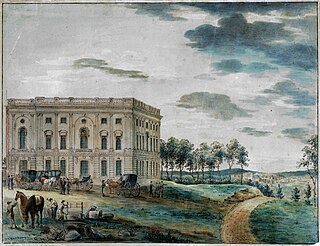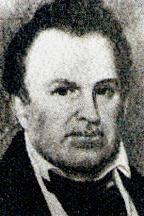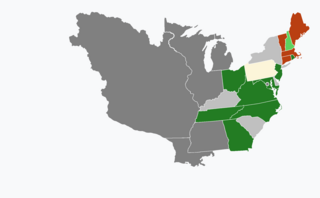
The 8th United States Congress was a meeting of the legislative branch of the United States federal government, consisting of the United States Senate and the United States House of Representatives. It met in Washington, D.C. from March 4, 1803, to March 4, 1805, during the last two years of Thomas Jefferson's first term in office. The apportionment of seats in the House of Representatives was based on the 1800 United States census. Both chambers had a Democratic-Republican majority.

The 9th United States Congress was a meeting of the legislative branch of the United States federal government, consisting of the United States Senate and the United States House of Representatives. It met in Washington, D.C., from March 4, 1805, to March 4, 1807, during the fifth and sixth years of Thomas Jefferson's presidency. The apportionment of seats in the House of Representatives was based on the 1800 United States census. Both chambers had a Democratic-Republican majority.

The 10th United States Congress was a meeting of the legislative branch of the United States federal government, consisting of the Senate and the House of Representatives. It met in Washington, D.C., from March 4, 1807, to March 4, 1809, during the seventh and eighth years of Thomas Jefferson's presidency. The apportionment of seats in the House of Representatives was based on the 1800 census; both chambers had an overwhelming Democratic-Republican majority.
John Smith was one of the first two U.S. senators from the state of Ohio. He reluctantly resigned from the Senate under charges of alleged complicity in the Burr conspiracy.

Thomas Morris was an American politician from Ohio who served in the United States Senate and was a member of the Democratic Party. In the 1844 presidential election, he was the vice presidential nominee of the anti-slavery Liberty Party.
Philemon Beecher was an Anglo-American attorney and legislator who was a member of the United States House of Representatives from Ohio.

William W. Irvin also spelled Irwin was a 19th-century lawyer, farmer, politician, and two-term U.S. Representative from Ohio from 1829 to 1833.

The 30th New York State Legislature, consisting of the New York State Senate and the New York State Assembly, met from January 27 to April 7, 1807, during the third year of Morgan Lewis's governorship, in Albany.

The 32nd New York State Legislature, consisting of the New York State Senate and the New York State Assembly, met from November 1, 1808, to March 30, 1809, during the second year of Daniel D. Tompkins's governorship, in Albany.

The 33rd New York State Legislature, consisting of the New York State Senate and the New York State Assembly, met from January 30 to April 6, 1810, during the third year of Daniel D. Tompkins's governorship, in Albany.

The 34th New York State Legislature, consisting of the New York State Senate and the New York State Assembly, met from January 29 to April 9, 1811, during the fourth year of Daniel D. Tompkins's governorship, in Albany.

The 91st New York State Legislature, consisting of the New York State Senate and the New York State Assembly, met from January 7 to May 6, 1868, during the fourth year of Reuben E. Fenton's governorship, in Albany.
James Pritchard was an American Revolutionary War veteran and Democratic-Republican politician who served in the legislatures of the Northwest Territory, and later in Ohio, and was unsuccessful in runs for congress.

The 169th New York State Legislature, consisting of the New York State Senate and the New York State Assembly, met from January 7, 1953, to June 10, 1954, during the eleventh and twelfth years of Thomas E. Dewey's governorship, in Albany.
Thomas Quin Ashburn was an American judge on the Supreme Court Commission of Ohio from 1876 to 1879, and a member of the Ohio State Senate for twelve days at the end of his life in 1890.

The First Ohio General Assembly was the initial meeting of the Ohio state legislature, composed of the Ohio State Senate and the Ohio House of Representatives. It convened in Chillicothe, Ohio, on March 1, 1803, and adjourned April 16, 1803. This General Assembly coincided with the first year of Edward Tiffin's first term as Ohio Governor.

The Second Ohio General Assembly was the second meeting of the Ohio state legislature, composed of the Ohio State Senate and the Ohio House of Representatives. It convened in Chillicothe, Ohio, on December 5, 1803, and adjourned February 17, 1804. This General Assembly coincided with the second year of Edward Tiffin's first term as Ohio Governor.

United States gubernatorial elections were held in 1805, in 13 states.

The Third Ohio General Assembly was the third meeting of the Ohio state legislature, composed of the Ohio State Senate and the Ohio House of Representatives. It convened in Chillicothe, Ohio, on December 3, 1804, and adjourned February 22, 1805. This General Assembly coincided with the last year of Edward Tiffin's first term as Ohio Governor.

The Fourth Ohio General Assembly was the fourth meeting of the Ohio state legislature, composed of the Ohio State Senate and the Ohio House of Representatives. It convened in Chillicothe, Ohio, on December 2, 1805, and adjourned January 27, 1806. This General Assembly coincided with the first year of Edward Tiffin's second and final term as Ohio Governor.








